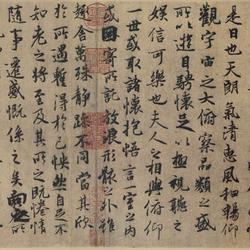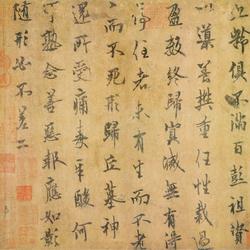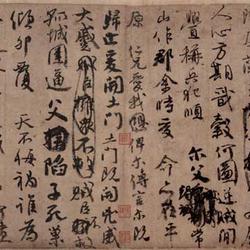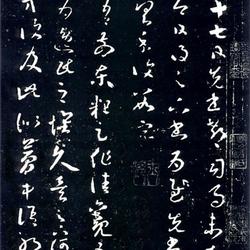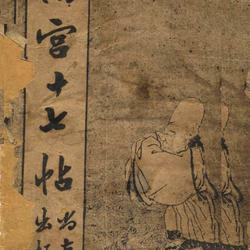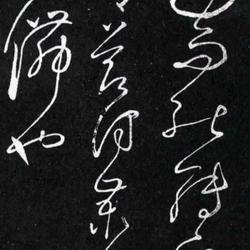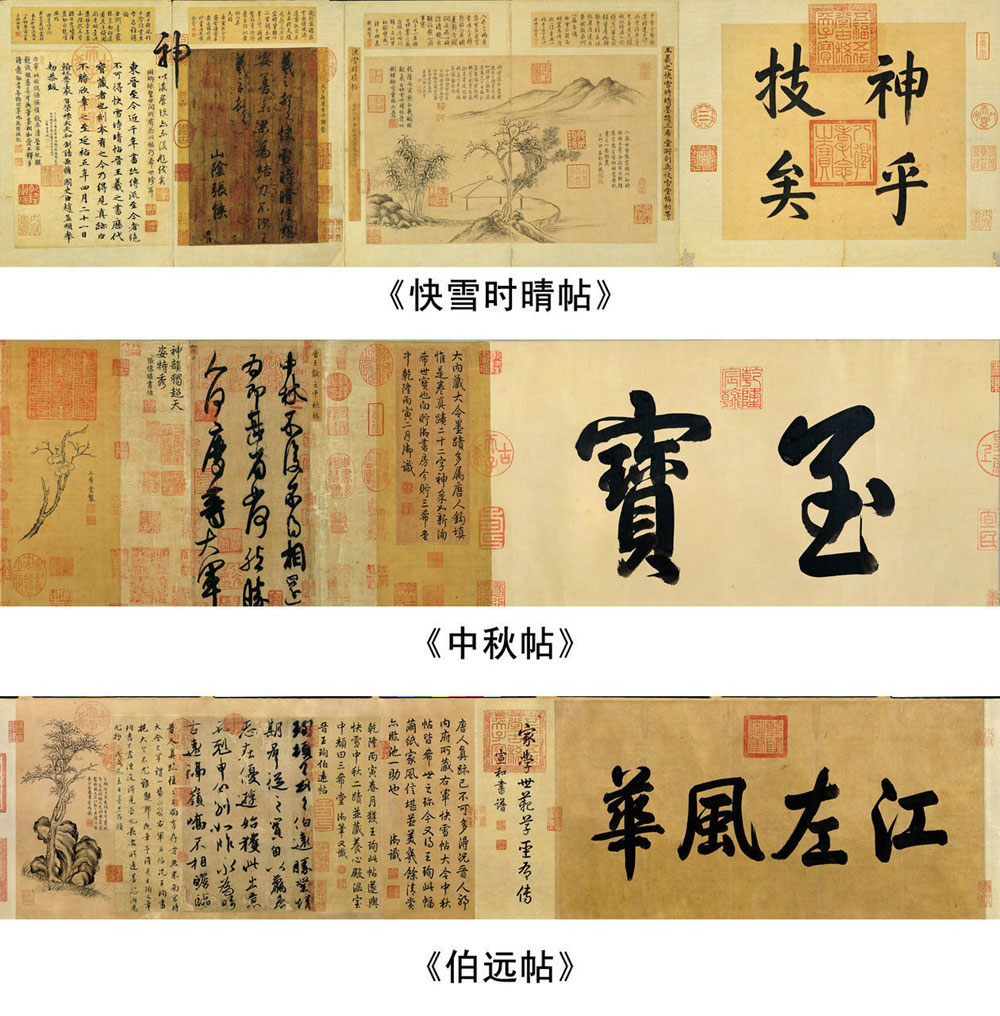
Introduction to "San Xi Bao Tie":
The so-called "Three Xibao Tie" are Wang Xizhi's "Quick Snow and Shi Qing Tie", Wang Xianzhi's "Mid-Autumn Tie", and Wang Xun's "Boyuan Tie".
Emperor Qianlong of the Qing Dynasty loved calligraphy, so he specially set up a small warm pavilion of less than ten square meters next to his bedroom to collect three name stickers representing the highest level of Chinese calligraphy art for him to view at any time. Later, this pavilion was used by Qianlong The emperor personally named it "Sanxi Pavilion", and the "Kuaixue Shiqing Tie", "Mid-Autumn Tie" and "Boyuan Tie" hidden in this pavilion were collectively called "Sanxi Tie" by later generations. After the Revolution of 1911, the Qing Dynasty fell. Among the "Three Xi Tie", except Wang Xizhi's "Quick Snow and Sunny Tie" which is still collected in the Palace Museum, Wang Xun's "Bo Yuan Tie" and Wang Xianzhi's "Mid-Autumn Tie" leaked out of the palace. No one knows where to go.On November 5, 1951, among the "Three Xi Tie", Wang Xianzhi's "Mid-Autumn Tie" and Wang Xun's "Boyuan Tie" were purchased from Hong Kong for 350,000 Hong Kong dollars under the personal instruction of Premier Zhou Enlai after several years of circulation. , returned to the Palace Museum in Beijing.
Many people believe that "Kuaixueshiqingtie" is another masterpiece of running script second only to "Lanting Preface" written by Wang Xizhi, which is "the best running script in the world". Zhao Mengfu, Liu Geng, Hudu Taer, Liu Chengxi, Wang Zhideng, Wen Zhenheng, Wu Ting, Liang Shizheng and others all expressed surprise and admiration in their postscripts. Qianlong loved calligraphy all his life. He deliberately searched for famous calligraphy works of the past dynasties, compiled them from hundreds of calligraphy masters, and pursued the essence of two kings. He cherished "Quick Snow and Clear Tie" very much. In front of the post, he wrote eight small characters "unparalleled in the world, unique in ancient and modern times" and four big characters "amazing skills". He also said: "The dragon leaps over the Tianmen, and the tiger lies in the Phoenix Pavilion." There are twenty-eight characters in the book, and each word is a pearl. It is known as the "Twenty-Eight Li Pearls". He hid this calligraphy together with the three Jin people's calligraphy of Wang Xun's "Boyuan Calligraphy" and Wang Xianzhi's "Mid-Autumn Calligraphy" in the Yangxin Hall. In the Xinuan Pavilion, there is a plaque "Sanxi Hall" written by Emperor Qianlong, which is regarded as a rare treasure. Wang Xizhi's "Quick Snow Shi Qing Tie" was regarded by Emperor Qianlong as the first of the "Three Xi". In the 12th year of Qianlong's reign, he selected 134 authentic calligraphers from the Wei, Jin, Tang, Song, Yuan and Ming Dynasties collected in the imperial palace, including San Xi, and copied them on stone. , named "Sanxitang Dharma Tie". The "Yue Gu Building" was built in Beihai in Xiyuan, and the above-mentioned carved stones were embedded in the walls of the building. The rubbings were circulated to show the model of Linchi. The original copy of Sanxi is still hidden in the Sanxi Hall of Yangxin Hall.
According to the many inscriptions, collection seals and related book records on the attached pages of this post, "Kuaixue Shiqing Tie" was once in the imperial palace of Xuanhe in the Song Dynasty, in Mifu's "Baojinzhai" in the Song Dynasty, and in the imperial palace in the Yuan Dynasty. There is an inscription and postscript by Zhao Mengfu on it. It was owned by Zhu Chengguo and Wang Zhideng in the Ming Dynasty, and by Feng Quan and Feng Yuanji in the Qing Dynasty. On August 18, the 16th year of Kangxi's reign in the Qing Dynasty (AD 1677), Feng Yuanji presented it to Emperor Kangxi and entered the inner palace. In 1949, the Kuomintang troops were defeated in the civil war. When they retreated to Taiwan, they took with them not only a large amount of gold, but also 2,972 boxes of exquisite cultural relics that had been moved south. This part is a masterpiece among the cultural relics of the Palace Museum, such as exquisite handicrafts, jade cabbage, jade incense burner, jade lotus leaf-shaped brush wash, etc., including Wang Xizhi's "Quick Snow and Clear Tie". Nowadays, "Three Hopes", "Boyuan Tie" and "Mid-Autumn Tie" are now in the National Palace Museum in Beijing. Only "One Hope", "Quick Snow and Clear Tie" is collected in the National Palace Museum in Taipei. The "Three Greeks" have not yet gathered together, which is a deep regret for the Chinese people.
"Mid-Autumn Tie" is said to be written by Wang Xianzhi, and the word "Treasure" on the post was inscribed by Emperor Qianlong himself. However, according to expert appraisal, "Mid-Autumn Tie" and "Kuaixueshiqing Tie" were copied by later generations, and only Wang Xun's "Boyuan Tie" is authentic.
1. A post about snow and sunshine soon
【Name】Quick Snow and Clear Post
【Category】Chinese calligraphy
【Author】Wang Xizhi
【Form】Paper
【Era】Jin
[Original size] 23cm in height; 14.8cm in width
[Finished product size] 23cm in length; 14.8cm in width
[Current Situation of Cultural Relics] Collection of the National Palace Museum, Taipei
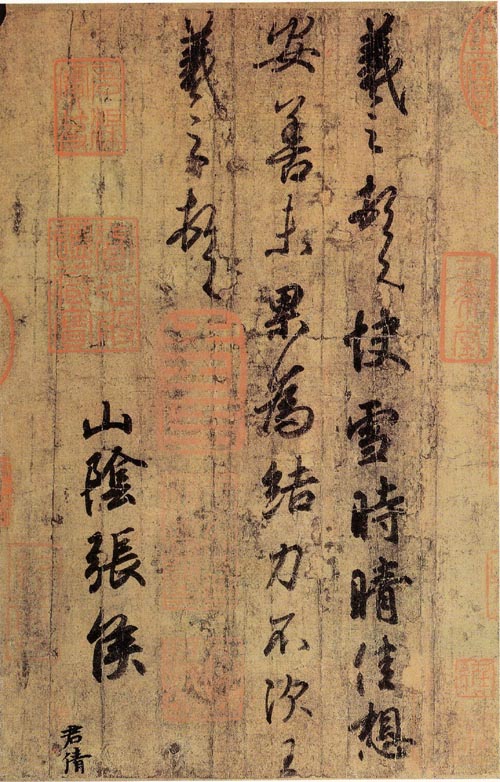
Wang Xizhi's "Quick Snow and Sunny Post"
"Quick Snow and Clear Tie" is a calligraphy work by Wang Xizhi, a calligrapher of the Jin Dynasty. It is written in running script. It is suspected that the existing calligraphy is a Tang Dynasty copy, and it has not yet been determined. The length of the sticker is 23cm; the width is 14.8cm, with four lines of running script and twenty-eight characters. "Tie to Clear Snow and Clear Snow" is a letter in which the author writes about his happy mood and greetings to his relatives when the snow clears at the beginning.
original:Xi Zhi paused. Soon it will snow and then it will clear, I wish you peace and good. No result is the result. Not strong enough. Wang Xizhi paused. Shanyin Zhanghou.
Original meaning:Wang Xizhi paid his respects: It snowed for a while just now, and now it’s sunny again. I guess everything is fine there! That incident didn't help, and I still feel confused. Many things in the world are so helpless. Wang Xizhi paid homage to him, and Marquis Zhang of Shanyin consecrated him personally.
When watching the CCTV documentary "Taipei National Palace Museum", Shiqing's post explaining Kuai Xue was as follows: Hello Mr. Zhang from Shan'in, it snowed just now, and now it's sunny again. I guess everything is fine where you are! I couldn't go to the last party and I felt very depressed. The person who delivered the letter to your family said that he could not stay here longer and had to go back quickly, so I will write these first. Yours sincerely, Wang Xizhi.
Appreciation:
After the heavy snowfall, the weather turned sunny, and Wang Xizhi used this short note to express his greetings to his friends. The last line "Sanyin Zhanghou" may be the name of the recipient. It was originally written on the cover of the letter, but is copied here together with the original on the same piece of paper.
This piece of calligraphy is mainly composed of round pens that hide the edge. When starting and closing the pen, the strokes, hooks, and waves are not exposed. The brushwork is mostly circular from horizontal to vertical. The structure is even and stable, showing calmness and calmness. The Ming Dynasty connoisseur Zhan Jingfeng described its characteristics as "round, vigorous, elegant, leisurely and leisurely, and unfathomable in taste", and believed that Zhao Mengfu was influenced by this calligraphy. However, Wang Xizhi was restrained and submissive, while Zhao Mengfu showed a slight edge. Comparing the inscriptions and postscripts of Zhao Mengfu, we can get this impression.
王羲之书法的特点在於优美的“体势”,“体”是指结字的形状和姿态,“势”是指笔画产生的律动感,以“快”字为例,左右相向的两部份,有著呼应的关系,“ 夬”的右肩略微高耸,末笔右顿,调和了倾斜的姿势。“雪”字也有类似的情形,上部向左倾斜,末一横画收笔有向右下的笔势,所以也调整了整个字的重心。第一行感觉上下的“行气”一贯,为什麼有这样的感觉呢?如果只看每个字横向的笔画,可以发现倾斜的角度大致相同,而同一行字的重心也都在同一中线上,第二行则有些变化,“果为”有连笔,其他的字间距较疏,重心也有偏右偏左的变化。这些变化显得很自然,也使得这短短的三行具有丰富的美感。
历史回顾:
不少人认为《快雪时晴帖》仅次于他所书的“天下第一行书”《兰亭序》的又一件行书代表作。 赵孟頫、刘赓、护都沓儿、刘承禧、王稚登、文震亨、吴廷、梁诗正等人的跋语中都表示惊羡和赞叹。乾隆一生酷爱书法,刻意搜求历代书法名品,综百氏而集其成,追二王而得其粹。他对《快雪时晴帖》极为珍爱,他在帖前写了“天下无双,古今鲜对”八个小字,“神乎其技”四个大字。又说:“龙跳天门,虎卧凤阁”。全书二十八字,字字珠玑,誉为“二十八骊珠”,他把此帖和王珣《伯远帖》、王献之《中秋帖》的晋人三帖,并藏于养心殿西暖阁内,乾隆御书匾额“三希堂”,视为稀世瑰宝。王羲之的《快雪时晴帖》被乾隆皇帝视为“三希”之首.乾隆十二年又精选内府所藏魏晋唐宋元明书家134家真迹,包括三希在内,摹勒上石,命名《三希堂法帖》。在西苑的北海建“阅古楼”,把上述刻石嵌在楼内墙上,拓本流传以示临池之模范。三希原件仍藏在养心殿三希堂。
根据此帖附页的诸多题跋款识、收藏印章以及有关书籍录载,《快雪时晴帖》曾经宋宣和内府,宋时入米芾“宝晋斋”,元代又入御府,上有赵孟頫题跋。明时为朱成国、王稚登,清冯铨、冯源济父子所有,于清康熙十六年(公元1677年)八月十八日 壬戌,冯源济进献康熙皇帝,入内府。1949年,国民党军队在内战中败北,退踞台湾时除带走了大量黄金以外,还有2972箱南迁文物中的精品。这部分却是故宫博物院文物中的精品,如精美绝伦的工艺品,翠玉白菜、玉香炉、玉荷叶形笔洗等,其中包括王羲之的《快雪时晴帖》。 如今“三希”《伯远帖》、《中秋帖》现存北京故宫博物院,唯独“一希”《快雪时晴帖》珍藏于台北故宫博物院。“三希”尚未聚首,国人深引为憾。
王羲之简介:
王羲之(303-361),山东临沂人,后徙居浙江会稽。字逸少,世称王右军,有“书圣”之誉。他出身仕宦名门,西晋末随父南渡,作过右军将军、会稽内史,东晋永和年间(345-356)去职,与东土名士尽山水之游。他热衷诗歌、音乐与书法。性好鹅,曾以书作换鹅。相传有绍兴蕺山老姥持竹扇卖二十钱,羲之书其扇各五字,增值为百钱,人们竞相购买。 王羲之书法初学卫夫人,后来改变初学,博采众长,草书师张芝(约卒於192),楷书学钟繇(151-230),又遍习蔡邕(133-192)、梁鹄(活动於二世纪后半)、张昶(卒於206)等书,精研体势,增损古法,一变汉、魏质朴书风,创妍美流变之体,所以唐人称赞他:“兼撮众法,备成一家,为万世宗师。 ”
2.中秋帖
【名称】中秋帖
【类别】中国法书
【作者】王献之
【形式】纸本
【年代】晋代
【原稿尺寸】纵27cm,横11.9cm
【成品尺寸】纵29cm,横48.5cm(画芯)
纵29cm,横341cm(手卷)
【文物现状】北京故宫博物院藏
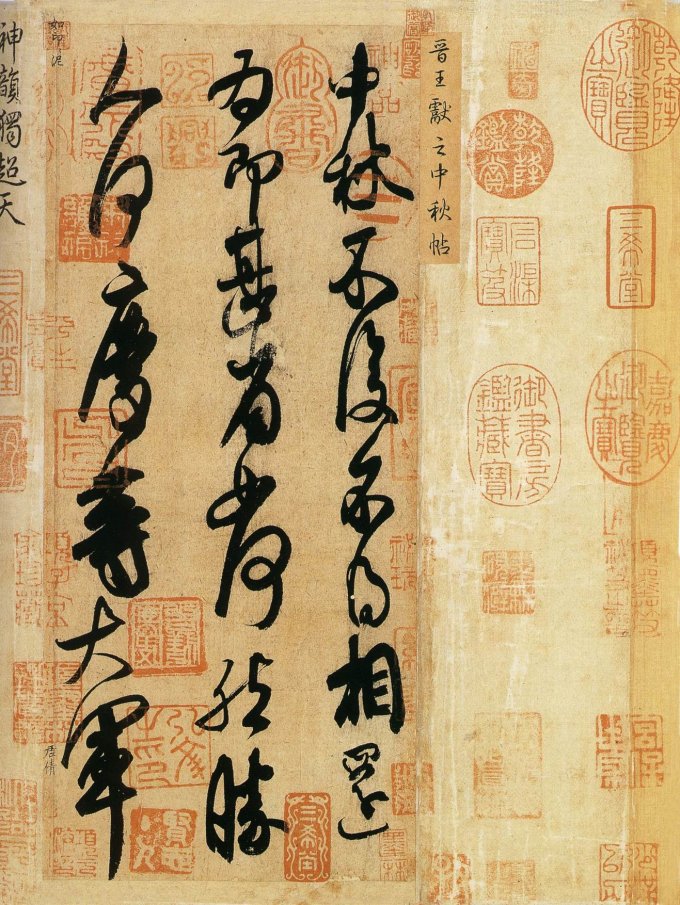
王献之《中秋帖》
全文为:“中秋。不复不得相。还,为即甚,省如何?然胜人何庆等大军。胡乱推测如下:“中秋节到了!你要是不回应我,你就别回来了。做就做了,想想又怎么样呢?就是胜利了,打败了对手,又怎么样呢?还要搞盛大的庆祝活动吗?浩浩荡荡的军队还要得胜还朝吗?
《中秋帖》,草书,纸本,传为晋王献之书 手卷,纵27cm,横11.9cm。
因原帖于“中秋”前有“十二月割至否”六个字,又名《十二月帖》,后这六字割失。该帖前后皆有缺文,原为五行三十二字,后被割去两行十字,现有三行二十二字。原帖前有唐代大书法家褚遂良题签“大令《十二月帖》”六个字。
此帖曾经宋代宣和、绍兴内府,明项元汴,清内府收藏。民国时溥仪将其携出宫外,流散民间。建国前和王珣《伯远帖》一起被典当于香港一家外国银行。
1951年底,典当期将满时,国外有人意图购获,周恩来总理闻讯,当即指示有关部门购回,入藏北京故宫博物院。
《中秋帖》用竹料纸书写,这种纸东晋时尚制造不出,约到北宋时方出现。
从行笔中可知,所用毛笔是柔软的无心笔,而晋朝使用的是有心硬笔,吸水性较差,笔的提、按、转折往往不能灵活自如,常出贼毫,如此帖那种丰润圆熟、线条连贯、行气贯通、潇洒飘逸的效果是写不出来的。
"Mid-Autumn Tie" should be Wang Xianzhi's cursive "one-stroke calligraphy" created in cursive script. It is known as the ancestor of "one-stroke calligraphy" and played a leading role in the emergence of cursive calligraphy in the Tang Dynasty.
Wang Xianzhi (344-386), courtesy name Zijing, Han nationality, was a calligrapher and poet from Linyi, Langya, Eastern Jin Dynasty. His ancestral home was Linyi, Shandong. He was born in Kuaiji (now Shaoxing, Zhejiang) and was the seventh son of Wang Xizhi. Wang Xianzhi learned calligraphy from his father Xizhi when he was young, and also studied calligraphy from Zhang Zhi. He is excellent in all styles of calligraphy, and is especially famous for his running cursive. He dares to innovate and is not limited by his father. He has made outstanding contributions to Jinkai and Jincao since the Wei and Jin Dynasties. He is known as the "Little Sage" in the history of calligraphy, equal to his father. Known as the "Two Kings". He once held official positions such as Prefectural Registrar, Secretary Lang, Secretary Cheng, Chang Shi, and Wuxing Prefect. After becoming Emperor Jianwen's consort, he was promoted to Zhongshu Ling (equivalent to prime minister). But his political achievements were average and far less prominent than the title of his book. The old friend called him "Da Ling".
3. Boyuan tie
【Name】Bo Yuantie
【Category】Chinese calligraphy
【Author】Wang Xun
[Form] Paper, running script, hand scroll
【Era】Jin
[Original size] 25.1 cm vertical, 17.4 cm horizontal
[Finished product size] 30 cm in length, 48.5 cm in width (painted core)
30 cm long, 442.2 cm wide (hand-rolled)
[Current Situation of Cultural Relics] Collection of the Palace Museum, Beijing
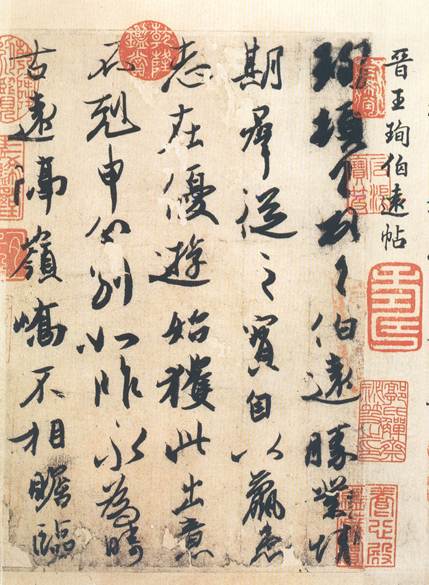
Wang Xun's "Bo Yuan Tie"
Original text: Xun Dun first bows his head, Boyuan wins the karma and love period, and is the treasure of the group. Since I am suffering from illness, I am determined to travel well. When I first got this idea, I couldn't help it. We are as different as yesterday, and they will remain ancient forever. Far away from each other, we can't see each other
"Bo Yuan Tie" is a letter written by King Xun of Jin Dynasty. The general idea is: Boyuan is a person of the same clan, and everyone has high hopes for him. He was in poor health, but had always wanted to travel far away. I just got the opportunity to travel, but unfortunately I didn't complete it. I was far away in the mountains and couldn't see him.
"Bo Yuan Tie" is an authentic work handed down by Wang Xun, a calligrapher of the Jin Dynasty. It is on paper, with a total of 5 lines and 47 characters. It is 25.1 cm long and 17.2 cm wide.It has always been regarded as a treasure by calligraphers, connoisseurs and collectors of later generations. "Bo Yuan Tie" is a letter from the king to his relatives and friends. It is known as one of the tenth best running script in the world, ranking fourth. Its strokes are steep, powerful, beautiful, natural and smooth, making it one of the best among ancient Chinese calligraphy works. It is listed as the third of the "Three Hopes". Its strokes are thinner and stronger, and the structure is more open. Especially the characters with few strokes are particularly comfortable and elegant. It is really a bit like "like the rising sun, like the breeze, like clouds, like clouds, like smoke, like the winding cave in the forest." "The charm of Jin people.
Wang Xun, also known as Yuan Lin, was the grandson of Wang Dao and the son of Wang Qia. He was born in the fifth year of Yonghe reign of Emperor Mu of Jin Dynasty (349 years) and died in the fourth year of Longan reign of Emperor An Dynasty (400 years). Emperor Xiaowu's Sima Yao, who was well versed in classics, Wang Xun and Yin Zhongkan, Xu Miao, Wang Gong, Xi Hui, etc., were all known to Emperor Xiaowu for their talents and scholarly articles. In the first year of Long'an of Emperor An (397), Zhan Shi was moved to Shangshu Ling, and he was appointed as a regular attendant. He died of illness at the age of fifty-two, and was given the posthumous title of Xianmu.

